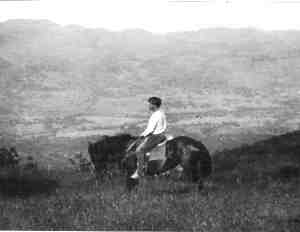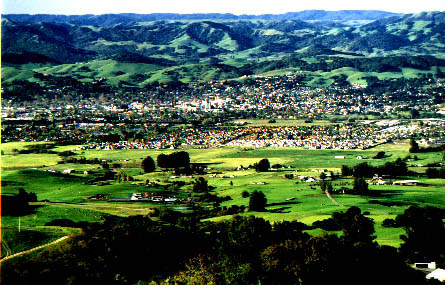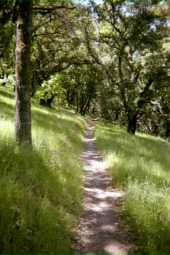| |
Jack London's Description of the
View from Sonoma Mountain
 Editor's note: In the early
years of this century, writer Jack London owned and lived
on a ranch near Glen Ellen which extended to the top of
Sonoma Mountain. Much of this ranch now makes up Jack
London State Historic Park. The "southern
edge of the peak" mentioned in this excerpt would be
at or very near Lafferty's upper meadow. Editor's note: In the early
years of this century, writer Jack London owned and lived
on a ranch near Glen Ellen which extended to the top of
Sonoma Mountain. Much of this ranch now makes up Jack
London State Historic Park. The "southern
edge of the peak" mentioned in this excerpt would be
at or very near Lafferty's upper meadow.
There were no houses
in the summit of Sonoma Mountain, and, all alone
under the azure California sky, he reined in on the
southern edge of the peak. He saw open pasture
country, intersected with wooded canons, descending
to the south and west from his feet, crease on crease
and roll on roll, from lower level to lower level, to
the floor of Petaluma Valley, flat as a billiard-table,
a cardboard affair, all patches and squares of
geometrical regularity where the fat freeholds were
farmed. Beyond, to the west, rose range on range of
mountains cuddling purple mists of atmosphere in
their valleys; and still beyond, over the last range
of all, he saw the silver sheen of the Pacific.
Swinging his horse, he surveyed the west and north,
from Santa Rosa to St. Helena, and on to the east,
across Sonoma to the chaparral-covered range that
shut off the view of Napa Valley. Here, part way up
the eastern wall of Sonoma Valley, in range of a line
intersecting the little village of Glen Ellen, he
made out a scar upon a hillside. His first thought
was that it was the dump of a mine tunnel, but
remembering that he was not in gold-bearing country,
he dismissed the scar from his mind and continued the
circle of his survey to the southeast, where, across
the waters of San Pablo Bay, he could see, sharp and
distant, the twin peaks of Mount Diablo. To the south
was Mount Tamalpais, and, yes, he was right, fifty
miles away, where the draughty winds of the Pacific
blew in the Golden Gate, the smoke of San Francisco
made a low-lying haze against the sky.
"I ain't seen so
much country all at once in many a day," he
thought aloud.
From Part II, Chapter
8 of Burning Daylight, serialized in The New York Herald, June-August,
1910.

Spring view today from Lafferty
Ranch on Sonoma Mountain
toward Petaluma and beyond. Photograph by Scott Hess.
Robert Louis Stevenson's description of
ascending
a nearby Sonoma or Napa county ridge
A rough
smack of resin was in the air, and a crystal mountain
purity. It came pouring over these green slopes by
the oceanful. The woods sang aloud, and gave largely
of their healthful breath. Gladness seemed to inhabit
these upper zones, and we had left indifference
behind us in the valley. "I to the hills lift
mine eyes!" There are days in a life when thus
to climb out of the lowlands, seems like scaling
heaven.
From Chapter II, "First
Impressions of Silverado" of Silverado
Squatters by Robert Louis Stevenson
Henry David Thoreau
on our need to walk in nature
 At present, in this
vicinity, the best part of the land is not
private property; the landscape is not owned,
and the walker enjoys comparative freedom.
But possibly the day will come when it will
be partitioned off into so-called pleasure-grounds,
in which a few will take a narrow and
exclusive pleasure only--when fences shall be
multiplied, and man-traps and other engines
invented to confine men to the PUBLIC road,
and walking over the surface of God's earth
shall be construed to mean trespassing on
some gentleman's grounds. To enjoy a thing
exclusively is commonly to exclude yourself
from the true enjoyment of it. Let us improve
our opportunities, then, before the evil days
come. At present, in this
vicinity, the best part of the land is not
private property; the landscape is not owned,
and the walker enjoys comparative freedom.
But possibly the day will come when it will
be partitioned off into so-called pleasure-grounds,
in which a few will take a narrow and
exclusive pleasure only--when fences shall be
multiplied, and man-traps and other engines
invented to confine men to the PUBLIC road,
and walking over the surface of God's earth
shall be construed to mean trespassing on
some gentleman's grounds. To enjoy a thing
exclusively is commonly to exclude yourself
from the true enjoyment of it. Let us improve
our opportunities, then, before the evil days
come.
From "Walking"
by Henry David Thoreau
So,
if there is any central and commanding
hilltop, it should be reserved for the public
use. Think of a mountaintop in the township,
even to the Indians a sacred place, only
accessible through private grounds. A temple,
as it were, which you cannot enter without
trespassing—nay, the temple itself
private property and standing in a man’s
cow-yard, for such is commonly the case. ...
That area should be left unappropriated for
modesty and reverence’s sake—if
only to suggest that the traveller who climbs
thither in a degree rises above himself, as
well as his native valley, and leaves some of
his grovelling habits behind.
I know it is a
mere figure of speech to talk about temples
nowadays, when men recognize none and
associate the word with heathenism. Most men,
it appears to me, do not care for Nature and
would sell their share in all her beauty for
as long as they may live for a stated and not
very large sum. ... It is for the very reason
that some do not care for these things that
we need to combine to protect all from the
vandalism of a few.
... I think that each town should have a
park, or rather a primitive forest, of five
hundred or a thousand acres, either in one
body or several—a common possession
forever, for instruction and recreation. ...
It frequently happens that what the city
prides itself on most is its park, those
acres which require to be the least altered
from their original condition.
From "Wild
Fruits"
by Henry David Thoreau
|
 |
|
 Editor's note: In the early
years of this century, writer Jack London owned and lived
on a ranch near Glen Ellen which extended to the top of
Sonoma Mountain. Much of this ranch now makes up
Editor's note: In the early
years of this century, writer Jack London owned and lived
on a ranch near Glen Ellen which extended to the top of
Sonoma Mountain. Much of this ranch now makes up 
 At present, in this
vicinity, the best part of the land is not
private property; the landscape is not owned,
and the walker enjoys comparative freedom.
But possibly the day will come when it will
be partitioned off into so-called pleasure-grounds,
in which a few will take a narrow and
exclusive pleasure only--when fences shall be
multiplied, and man-traps and other engines
invented to confine men to the PUBLIC road,
and walking over the surface of God's earth
shall be construed to mean trespassing on
some gentleman's grounds. To enjoy a thing
exclusively is commonly to exclude yourself
from the true enjoyment of it. Let us improve
our opportunities, then, before the evil days
come.
At present, in this
vicinity, the best part of the land is not
private property; the landscape is not owned,
and the walker enjoys comparative freedom.
But possibly the day will come when it will
be partitioned off into so-called pleasure-grounds,
in which a few will take a narrow and
exclusive pleasure only--when fences shall be
multiplied, and man-traps and other engines
invented to confine men to the PUBLIC road,
and walking over the surface of God's earth
shall be construed to mean trespassing on
some gentleman's grounds. To enjoy a thing
exclusively is commonly to exclude yourself
from the true enjoyment of it. Let us improve
our opportunities, then, before the evil days
come.